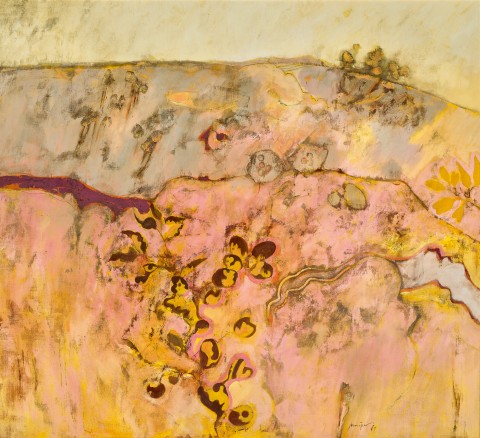GREENMOUNT HILL, 1969
ROBERT JUNIPER
oil on canvas
150.5 x 167.0 cm
signed and dated lower right: Juniper / ‘69
inscribed with title verso: “Greenmount Hill”
Probably: Skinner Galleries, Perth
The National Australia Bank Art Collection, acquired in 1975 (label attached verso)
The Seventies: Australian Paintings and Tapestries from the Collection of National Australia Bank, National Gallery of Victoria, Melbourne, 15 October – 28 November 1982
Australian Pavilion at the World Expo '88, Australian Pavilion, Brisbane, 7 April - 4 November 1988
The Seventies Exhibition: Selected Paintings from the National Australia Bank Collection, MacLaurin Hall, The University of Sydney, Sydney, 6 September - 1 October 1989, cat. 21 (as 'Green Mount [sic.] Hill')
The Seventies: Contemporary Australian Paintings from the National Australia Bank Collection, organised by Regional Galleries Association of New South Wales, New South Wales, cat. 18; and touring, Tamworth City Art Gallery, New South Wales, 24 May – 24 June 1990; Dubbo Regional Art Gallery, New South Wales, 11 July – 6 August 1990; Wagga Wagga City Art Gallery, New South Wales, 17 August – 10 September 1990; Moree Plains Regional Gallery, New South Wales, 3 October – 31 October 1990
Lindsay, R., The Seventies: Australian Paintings and Tapestries from the Collection of National Australia Bank, The National Bank of Australasia, Melbourne, 1982, pl. 51, p. 64 (illus.)
Greenmount Hill, 1967, oil, synthetic polymer paint and gesso on canvas, 167.0 x 176.0 cm, in the collection of Artbank, Melbourne
The sharp and sudden incline of Greenmount Hill marks the approach to the Darling Ranges outside Perth, a geographical barrier between the coastal urban population and the endless miles of wheat fields that stretch beyond. Covered with jarrah forest, grass trees and indigenous flowering plants, it is also a short distance from Robert Juniper’s house and studio in Darlington which he built from rammed earth and salvaged materials between 1958 and 1961. A number of other artists also moved to the ranges in the 1950s and 60s forming a tight, supportive and critically attuned group of practitioners. They experimented widely with materials and Juniper was particularly innovative, having trained with commercial paint products whilst completing his study at the Beckenham School of Art and Industrial Design in Kent in the 1940s. Through the use of additives such as river sand and diatomaceous earth, he sought the recreate the visceral sensation of a formative childhood experience crawling around C. Y. O’Conner’s water pipe near Kalgoorlie. Here he encountered ‘the impression of a bush landscape... rocks, semi-desert and the textures; trees and their greenery; associated noise of insects;’1 and such tactile memories remain embedded in his mature works, such as Greenmount Hill, 1969.
Juniper found success early in his career by winning the inaugural Perth Prize for Contemporary Art in 1954, and through his inclusion in the landmark London exhibition Recent Australian painting at the Whitechapel Gallery in 1961. He was also taken under the wing of the charismatic Perth gallerist Rose Skinner whose eponymous business attracted the cream of Australian artists such as Nolan, Boyd, Drysdale and Olsen, all of whom Juniper socialised with through his patron’s largesse. He also assisted in hanging exhibitions at the gallery which enabled him to intimately study individual artist’s techniques, particularly Fred Williams, whose example became an important early influence. In 1964, Skinner organised a solo exhibition for her protégé in Tokyo and whilst he was unable to accompany that show, Juniper travelled to Japan later in 1967, staying for an extended period absorbing the country’s art. By this time, the artist had already developed an individualistic approach to his painting, using canvas stretched flat on a work bench and primed with a home-made gesso applied using a spatula, a process which allowed Juniper to model surface textures as he went. These were further enhanced with nicks and incisions before drying, after which acrylic paint was applied to pre-moistened areas, allowing it to run and spill like watercolour. After sealing with PVA, he then utilised oil paints embellished and thickened with textural additives.2 Following his experiences in Japan, the overlaying details added to his paintings became more elegant, even decorative, particularly when depicting plants, and this is particularly evident when comparing two versions of the same subject, Greenmount Hill, 1967, and the example on offer here, painted two years later. In both cases, they explicitly confront Juniper’s notion that having experienced the ‘orderly, worked-over Japanese landscape [he now] “longed for a bit of scruffy, dandruffy Australian bush. I’d stepped away from Australia and then suddenly saw the Australian landscape for its own unique beauty.”’3
1. Mink, S., ‘Of Robert Juniper’, Art and Australia¸ vol.16, no.4, June 1979, p.350. Juniper’s father was an engineer on the pipeline designed by C. Y. O’Connor (father of the artist Kathleen O’Connor) which brought water to the Kalgoorlie-Coolgardie goldfields.
2. Juniper’s working process is described in full in Artist in focus 2: Robert Juniper, exhibition flyer, Art Gallery of Western Australia, Perth, 1988, non-paginated.
3. Robert Juniper in conversation with John Scott, cited ibid.
ANDREW GAYNOR
